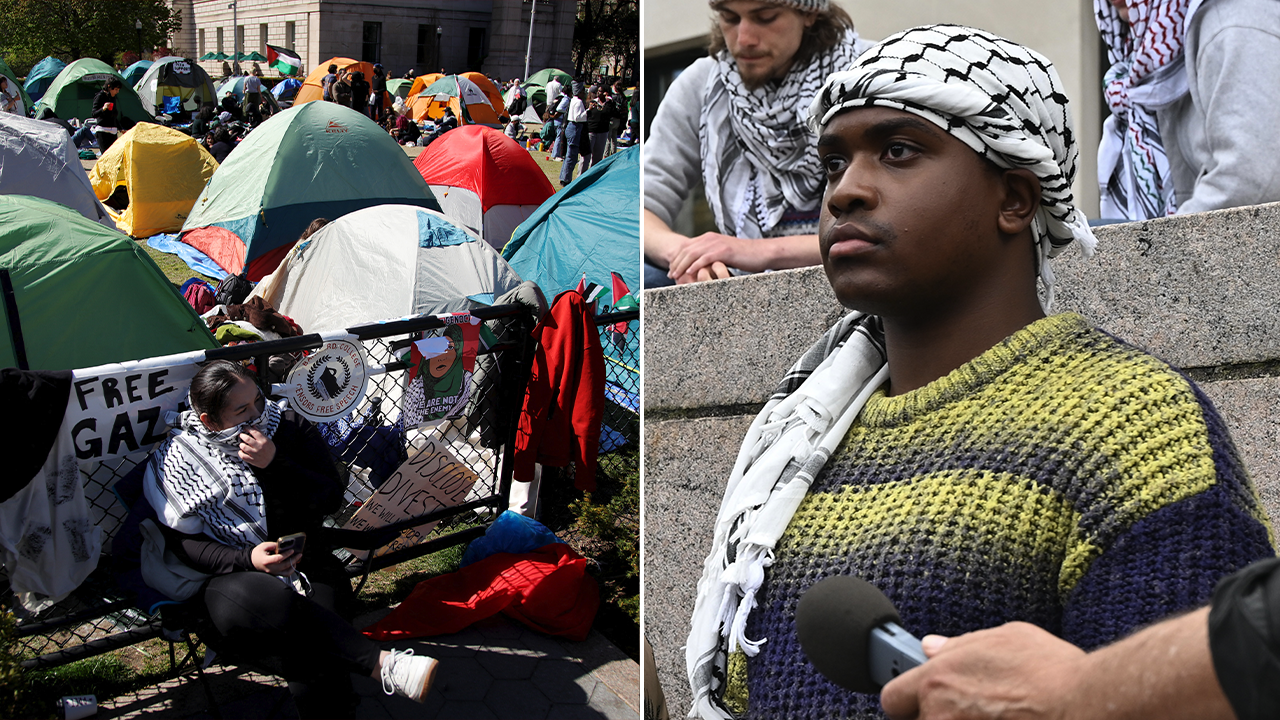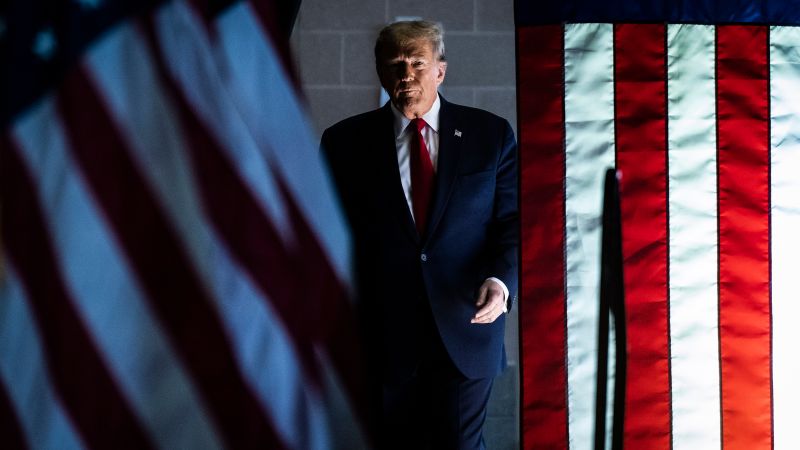Editing by Jeffrey Goldfarb and Aditya Sriwatsav
World
Breakingviews – Alphabet moonshots are ready for launch
/cloudfront-us-east-2.images.arcpublishing.com/reuters/7WGL4ZKKPBKZ5LNRR4IRTVLA4Q.jpg)
Alphabet logo and AI Artificial Intelligence words are seen in this illustration taken, May 4, 2023. REUTERS/Dado Ruvic/Illustration Acquire Licensing Rights
NEW YORK, Aug 29 (Reuters Breakingviews) – Alphabet (GOOGL.O) is poised to welcome the autumn harvest. Ruth Porat, the web search giant’s chief financial officer and a former technology investment banker at Morgan Stanley (MS.N), will move into a new role next month that includes overseeing “other bets,” an eclectic collection of experimental projects. It’s a good time to cull and rethink the cash-burning portfolio.
A shift is already underway at Verily Life Sciences, the health-data cruncher that generated some $560 million in revenue last year, the Wall Street Journal reported earlier this month. The sum accounted for more than half the $1 billion contributed by the non-search division. In 2022, Alphabet’s top line was more than $280 billion, yielding $60 billion of net profit. The “other bets” lost $6 billion.
Despite nearly doubling its top-line growth rate this year, Verily’s operating costs are also rising, according to tech news outfit The Information. Verily boss Stephen Gillett told employees this month that it will cut its ties to several of Alphabet’s services next year. The decision suggests that a spinoff could be on the horizon; Verily also has already raised outside capital from investors such as Singaporean wealth fund Temasek.
For Alphabet, cutting Verily loose would make sense. The business it incubated originally set out to develop a cancer-detection pill, but today Verily makes most of its money from selling an insurance product to employers. Such a financial services business strays from Alphabet’s wheelhouse, and with artificial intelligence demanding fresh attention, it’s wise to be prudent about capital allocation. Chris Hohn’s activist TCI Fund Investments publicly noted as much to the $1.6 trillion company last year.
Some other “other bets” also look like promising candidates for separation soon, too. Waymo, the autonomous vehicle technology business, secured a vote of approval this month from San Francisco to operate driverless rideshares in the city. Moreover, trouble in the sector has washed away some competitors like Ford Motor’s (F.N) similar business. After some years of stagnation, internet provider Google Fiber, another substantial source of revenue in Alphabet’s laboratory plans to expand again.
Other speculative efforts, however, could end up supplying important sources of long-term growth. For example, Porat moved DeepMind, an AI business once housed in “other bets,” under Google’s umbrella earlier this year. The decision suggests there’s merit in Alphabet backing unproven, early-stage ideas and trying to help them flourish, especially as trustbusters crack down on tech goliaths growing by acquisition. Some moonshots, however, demand to be launched.
(The author is a Reuters Breakingviews columnist. The opinions expressed are her own.)
Follow @AnitaRamaswamy on X
CONTEXT NEWS
Verily Life Sciences plans to stop using parent company Alphabet’s services, including real estate and software, by the end of 2024, Chief Executive Stephen Gillett told employees, technology publication The Information reported on Aug. 18.
The healthcare-focused unit reported an operating loss that was $17 million wider than it had projected for the first half of 2023, according to a Wall Street Journal article published on Aug. 16, citing an internal presentation. In 2022, Verily lost $568 million on $559 million of revenue, the newspaper reported.
Our Standards: The Thomson Reuters Trust Principles.
Opinions expressed are those of the author. They do not reflect the views of Reuters News, which, under the Trust Principles, is committed to integrity, independence, and freedom from bias.

World
Italian PM Meloni ally fires back against criticism says policies the same but 'Europe has changed'
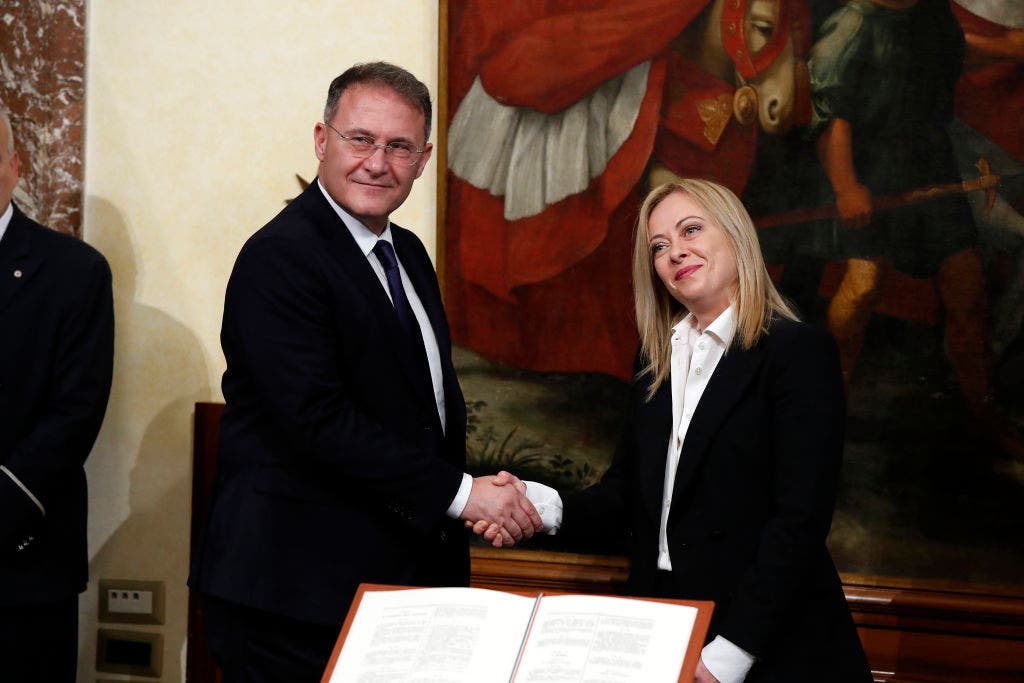
FIRST ON FOX – A close ally to Italian Prime Minister Giorgia Meloni told Fox News Digital that criticism against her for abandoning policies on illegal migration and other issues is unfounded.
Italian Vice Minister of Foreign Affairs Edmondo Cirielli told Fox News Digital, “Giorgia Meloni hasn’t changed, Europe has changed.” Cirielli is the co-founder and national coordinator of Meloni’s party, the Fratelli D’Italia Party.
He said Italy is inspiring the European Union president to follow its strong conservative stances.
MELONI’S SHIFT FROM ANTI-GLOBALIST TO PRO-EUROPE, BIDEN BUDDY INFURIATES BASE: ‘WILL NOT VOTE FOR HER ANYMORE’
The leader of Fratelli d’Italia, Giorgia Meloni, in Rome on Sept. 22, 2022 for the closing of the election campaign for the general election in Italy on Sept. 25, 2022. (Getty Images)
He said that the Europe of Ursula von der Leyen is paying attention to Italy’s policies and “is listening to Italy’s reasons. Italy has always wanted nations to be stronger in Europe and is leading the rest of the European Union on this. Von der Leyen herself is accompanying Meloni in her action against illegal immigration. They have already intervened in Egypt and Tunisia. We will soon do it in Libya too.”
He added “among other things, there are European elections in a few months and the conservative party led by Giorgia Meloni, the European Conservative Party led by Giorgia Meloni, will give a new direction to this Europe. And the European Parliament itself, the European People’s Party itself, will have to take into account the problems that exist today and that Giorgia Meloni identified during her electoral campaign.”
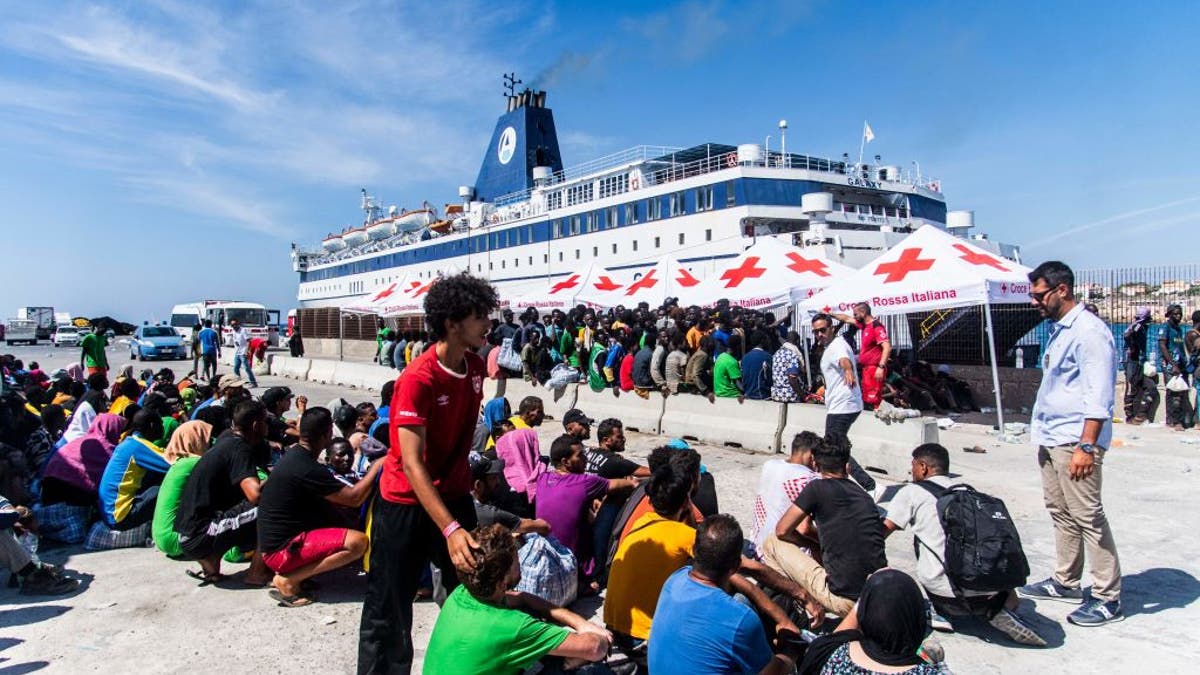
Migrants from a migrant housing center on the Italian island of Lampedusa are guided by a security official on Sept. 14, 2023 as they prepare to board the ship “Galaxy”, bound for the Sicilian town of Porto Empedocle. The island struggled to cope with a surge in migrant boats from North Africa after numbers peaked at 7,000 people, equivalent to the entire local population. (Photo by ALESSANDRO SERRANO/AFP via Getty Images)
Birth rates in Italy have dropped to a record low in 2023 with a 15th consecutive annual decline. In 2023, Italy recorded 379,000 births, a 3.6% decline from 2022.
Cirielli said the problem does not only concern Italy, but concerns all of Western Europe. In its 2024 budget, Italy earmarked around 1 billion Euros (approximately $1.1 billion) for several measures aimed at addressing Italy’s demographic crisis.
“We are implementing a series of policies aimed at supporting births, birth rates and young couples, both on an economic and financial level, and this is obviously also a social phenomenon. It’s about changing your mindset and understanding that life is an opportunity and a joy for everyone,” the deputy foreign minister said.
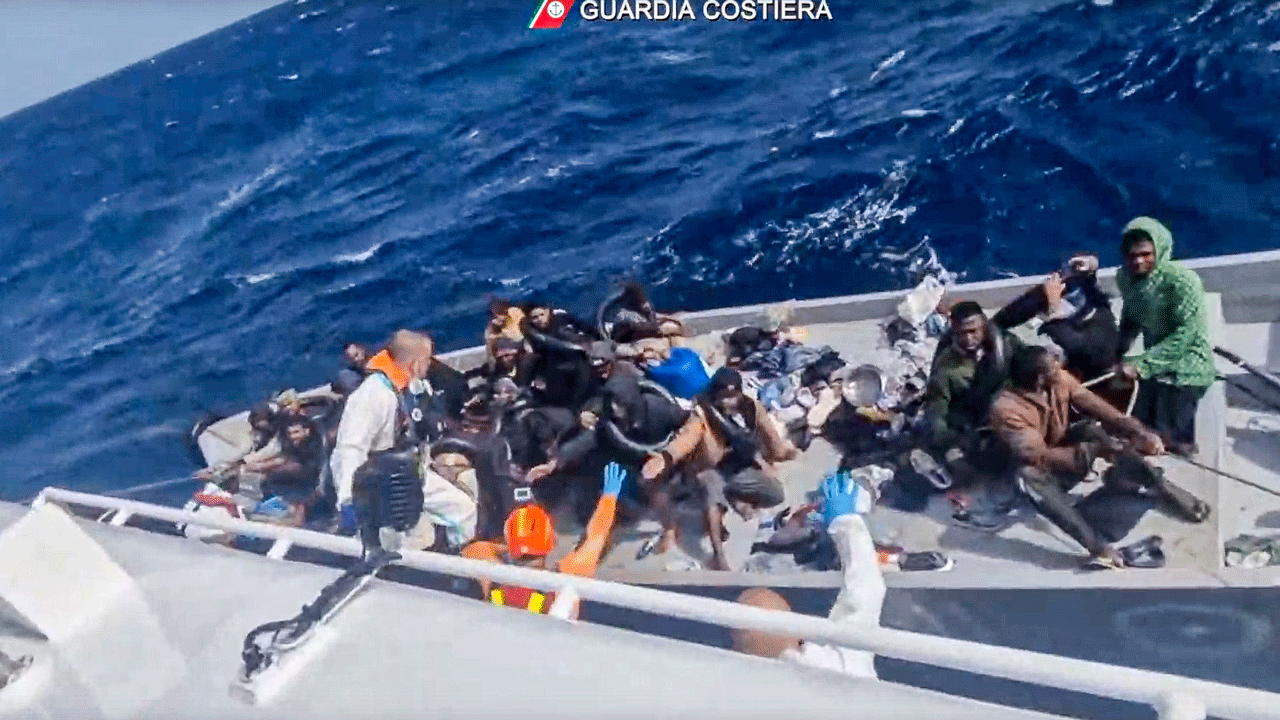
In this image taken from a video released by the Italian Coast Guard on Thursday, April 11, 2024, a boat with migrants is approached by a rescue operation off the island of Lampedusa in the Mediterranean Sea. The Italian Coast Guard rescued 22 people and recovered nine bodies on Thursday, April 10, 2024, after a smugglers’ boat capsized in storm about 30 miles south of the island of Lampedusa. (Photo: Italian Coast Guard.)
The journey from North Africa to Italy has become one of the busiest migration routes with data showing migrant arrivals jumping 50% in 2023 from the previous year.
Cirielli accompanied Prime Minister Meloni last week on her fourth visit to Tunisia in a year when they signed new accords as part of Italy’s “Mattei Plan” for Africa.

Italian Deputy Minister for Foreign Affairs and International Cooperation, Edmondo Cirielli, left, signs accords along with Italian Premier Giorgia Meloni and Tunisian President Kais Saied, center right. (Photo: Gerardo Antelmo/ Office of the Vice Minister Edmondo Cirielli.) (Gerardo Antelmo/ Office of the Vice Minister Edmondo Cirielli)
“We are faced with an epochal fact that does not only concern Italy,” said Cirielli.
MORE THAN 63,000 MIGRANTS HAVE DIED OR GONE MISSING SINCE 2014, UN AGENCY REPORTS
The Mattei Plan seeks to tackle education and training, agriculture, health, water and energy development while aiming to make Italy an energy hub to transport natural gas supplies from Africa to the rest of Europe.
“We are intervening, first of all, with agreements with North African countries to prevent the departures from these coasts, but above all, we are trying to come to the places of origin of the migration. They are trying to help development and at the same time also provide legal channels of migration. Because the real problem is not migration itself and rather it is the criminal organizations that are behind the trafficking of migrants which is creating a new slave trade.”
He added, “This globalization is becoming very powerful on a financial level, exploiting this trafficking and in this way destabilizing Africa, becoming criminal organizations that launder this money from international trafficking, funneling it into drugs, armaments and also to often support the causes of terrorist organizations.”
Under Italy’s rotating stewardship, the G-7 foreign ministers met last week on the Italian resort island of Capri with calls for new sanctions against Iran over its attack against Israel.
“Italy, with the presidency of the G-7, has condemned Iran’s action and knows well that Iran is carrying out a destabilizing action in the Arabian Peninsula in the Middle East, but it is equally true that we do not need an escalation… Israel’s bombing of a consular office, the diplomatic headquarters, was also a risky act. On the other hand, all of the G-7 noted that Iran’s response was a response, this time a balanced, moderate response compared to the episode itself.”

Italian Prime Minister Giorgia Meloni and Italian Undersecretary of the Ministry of Foreign Affairs and International Cooperation Edmondo Cirielli during the ceremony of Oath of the Undersecretaries at Palazzo Chigi. Rome (Italy), November 02nd, 2022 (Photo by Massimo Di Vita/Archivio Massimo Di Vita/Mondadori Portfolio via Getty Images)
Cirielli added “It was understood that the Iranian government does not want an escalation and therefore everyone agrees, in the G-7, at the invitation following the lead of Biden and Giorgia Meloni and neighbors who are close and ready to support,Israel, especially Israel’s right to defend itself and Israel’s right to exist. But we must carry forward a de-escalation and prevent a regional war from erupting from this issue in Gaza.”
In December, Italy withdrew from China’s Belt and Road Initiative which intended to rebuild the Silk Road to connect China with Asia and Europe by expanding China’s infrastructure spending on roads and shipping routes.
Cirielli says the move to withdraw is not an interruption between the relationship of Italy and China but in the best interest of Italian trade.
CLICK TO GET THE FOX NEWS APP
“It was a mistake by the Conte Government and the center-left governments that preceded us to make a political agreement because this seemed inconsistent with the alliance of the North Atlantic Treaty and also with the European Union…we terminated this agreement at the natural deadline and are establishing a new economic-social partnership, as like France and Germany have known. Therefore, there is not an interruption of relations, but a different modulation based on ancient, thousand-year-old relations almost only between the Italic peoples and the Chinese peoples, based absolutely on good dialogue, on profitable trade for both.”
The “Opposition had said that it is not wrong to have diplomatic relations or economic relations with China, it is wrong to have a political relationship that is underlying the agreement launched by China towards the world,” he concluded.
World
The Abu Ghraib abuse scandal 20 years on: What redress for victims?
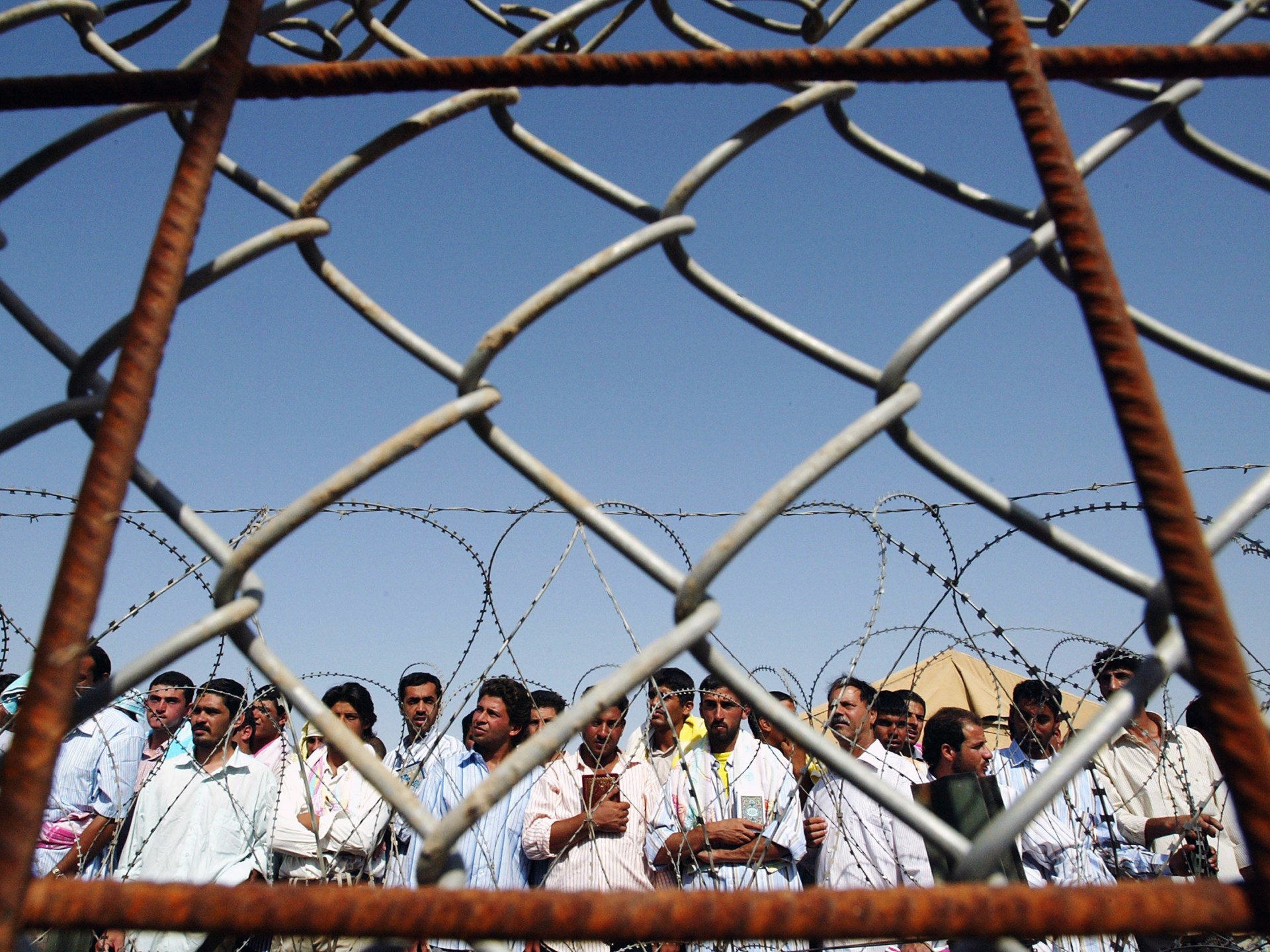
When the US TV news programme 60 Minutes II revealed images of Iraqi men being abused and humiliated by their American jailers at Abu Ghraib prison in Iraq 20 years ago this weekend, the United States-led invasion and subsequent occupation of Iraq was just 13 months old.
Toppled Iraqi President Saddam Hussein, who had been captured by US forces more than four months earlier, was awaiting trial on charges of crimes against humanity, and the Iraqi state itself was in the grip of violence and disorder.
For many in the Arab world, Abu Ghraib quickly became a symbol of US imperialism and hypocrisy, shattering then-US President George W Bush’s repeated claims that the US was a bastion of human rights.
Two decades later, a civil case that has been brought by Abu Ghraib victims against a US contractor that operated at the prison is under way. Many are now viewing Israel’s ongoing US-backed military action in the Gaza Strip, where more than 34,000 Palestinians have been killed since October, through the prism of the Abu Ghraib scandal, which first came to light on April 28, 2004, and sent shockwaves around the world.
What did the Abu Ghraib images show?
The photographs broadcast on 60 Minutes showed US guards at Abu Ghraib subjecting Iraqi prisoners to various forms of violence, sexual assault and humiliation. Many of the prisoners had been apprehended by US soldiers on suspicion of being part of armed groups, but according to the International Red Cross, 70 percent to 90 percent of them were innocent bystanders who had been arrested mistakenly.
One image showed naked prisoners heaped into a pyramid with their US captors standing smiling behind them. Another showed a US soldier holding a naked prisoner on a leash.
However, the defining image of the scandal proved to be the haunting depiction of a hooded Iraqi man holding electrical wires and standing on a box.
Then-US General Mark Kimmitt, who was deputy director of coalition operations in Iraq and was interviewed for the April 2004 CBS News story, said: “Frankly, I think all of us are disappointed at the actions of the few. You know, every day we love our soldiers, … but frankly, some days we’re not always proud of our soldiers.”
Subsequent revelations by CBS News disclosed that the US army report on which the US broadcaster had based its original story on Abu Ghraib had in fact detailed “numerous incidents of sadistic, blatant, and wanton criminal abuses” of Iraqis by US soldiers at the prison.
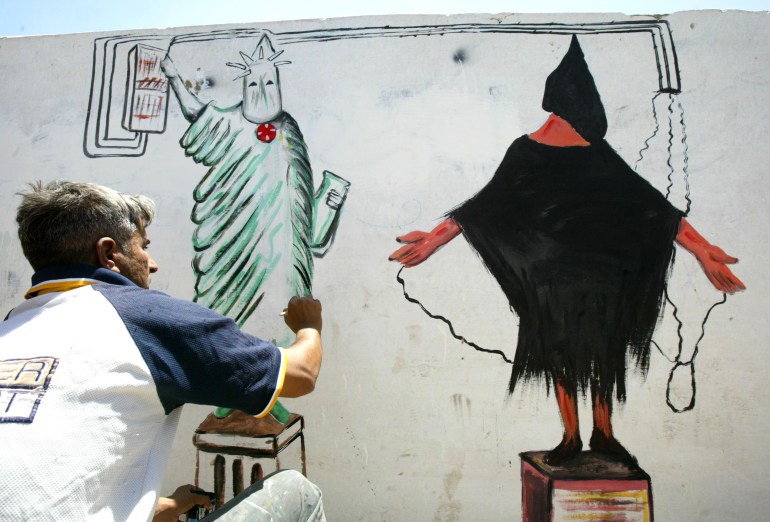
Was there any other evidence of abuse at Abu Ghraib?
Soon after the photographs of US soldiers humiliating and mistreating Iraq men were released on CBS News, the International Committee of the Red Cross published its own report on abuse at the prison.
The report detailed incidents of abuse witnessed by Red Cross observers from March to November 2003 and carried out “during arrest, internment and interrogation”, particularly of “persons arrested in connection with suspected security offences or deemed to have an ‘intelligence’ value”.
The Red Cross said it had uncovered numerous examples of violations of the Geneva Conventions by US military personnel. For example, the report said Red Cross observers had witnessed US soldiers mistreating Abu Ghraib prisoners by keeping them naked in total darkness in empty cells.
In the executive summary for its report, the Red Cross said so-called high value detainees “were at high risk of being subjected to a variety of harsh treatments ranging from insults, threats and humiliations to both physical and psychological coercion, which in some cases was tantamount to torture, in order to force cooperation with their interrogators”.
The abuse was, “in some cases, tantamount to torture”, the Red Cross report said.
Were any US soldiers held accountable?
Private Lynndie England, the soldier pictured holding a leash attached to a naked Iraqi man lying on the ground at Abu Ghraib prison, which had been a notorious place of torture during the presidency of Saddam Hussein himself, appeared in several prisoner abuse images. In 2005, England was found guilty of six counts of abuse by a US military court and sentenced to three years in prison. She was released in March 2007.
Charles Graner Jr, a US army prison guard convicted by a military court of leading the abuse of detainees at Abu Ghraib, was handed a 10-year prison term in 2005 after being convicted of five counts of assault, maltreatment and conspiracy. Graner was freed in August 2011.
Of the 11 soldiers court-martialled by the US military for mistreating Iraqi prisoners at Abu Ghraib, nine were given jail time.
But it soon became apparent that American abuse of Iraqi inmates was not confined to Abu Ghraib. Indeed, after CBS revealed the Abu Ghraib scandal, the news corporation started to learn of the existence of army investigator interviews that also brought to light the abuse of prisoners at other detention centres in Iraq, such as al-Mahmudiya prison, a temporary holding facility, for which other US military personnel were also jailed.
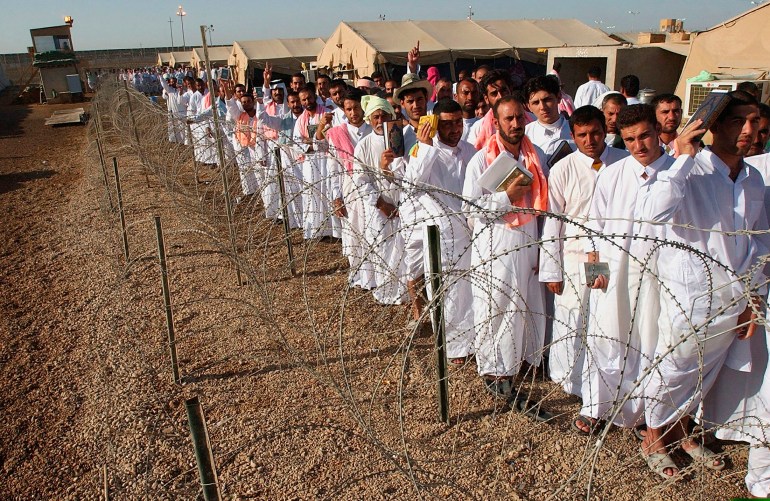
Have Iraqi victims of US torture received any kind of redress?
In September, Human Rights Watch said: “The US government has apparently failed to provide compensation or other redress to Iraqis who suffered torture and other abuse by US forces at Abu Ghraib and other US-run prisons in Iraq two decades ago.”
The existence of the Federal Tort Claims Act, which gives the US government immunity from any lawsuits arising during war, means seeking redress is particularly difficult.
Instead, Iraqi victims of US abuse have been forced to pursue US military contractors, which Chris Bartlett, a US photographer who has been shooting portraits of Abu Ghraib’s torture survivors since 2006, noted to Al Jazeera were “hired … to create a layer of liability distance so the federal government could be shielded from responsibility”.
Most recently, on April 15 this year, a federal court in Virginia began hearing the case of Al Shimari et al v CACI, a private security firm hired in 2003 by the US government to interrogate Iraqi prisoners at Abu Ghraib.
The defendants are being represented by the US-based Center for Constitutional Rights, which in 2013 won a $5m settlement for its Iraqi clients from Titan Corp, another military firm working at Abu Ghraib.
In the Virginia case, the advocacy group is seeking compensation for three Iraqi clients – Suhail Najim Abdullah Al Shimari, Salah Al-Ejaili and As’ad Al-Zuba’e – who allege that “CACI participated in a conspiracy to commit unlawful conduct including torture and war crimes at Abu Ghraib prison,” where they were tortured.
On Monday, the eight-person jury in the case retired to consider its verdict.
Why has Israel’s war on Gaza drawn comparisons with US torture at Abu Ghraib?
Israel’s deadly campaign of air strikes against the Hamas-governed Gaza Strip, which began on October 7, was soon followed by reports of Israeli soldiers beating and humiliating detained Palestinians, which many likened to US torture at Abu Ghraib.
On October 31, the pro-Palestinian advocacy group Jewish Voice for Peace wrote on X: “The footage of Israeli soldiers torturing Palestinian men in the West Bank is horrific. The Israeli military has brutally abused Palestinian prisoners for decades. As the Israeli military wages a genocidal war in Gaza, its soldiers are no longer hiding this abuse from the public.”
It added: “It’s no surprise … that the same government that tortured Iraqis in Abu Ghraib is funding the same tactics on Palestinians.”
Sarah Sanbar, an Iraq researcher at Human Rights Watch, told Al Jazeera that a former Iraqi detainee told her images of stripped Palestinians being rounded up and restrained by Israeli forces in Gaza were “very retraumatising and triggering and took him right back to 2003 and 2004 when he was being tortured [by the Americans] at Abu Ghraib”.
World
Has South Africa Truly Defeated Apartheid?

Thirty years ago, the South African miracle came true. Millions voted in the country’s first democratic elections, seemingly delivering a death blow to apartheid.
The African National Congress rose to power under the leadership of Nelson Mandela and used the Freedom Charter, a decades-old manifesto, as a guide to forming a new nation.
The charter’s 10 declarations offered a vision for overcoming apartheid through a free, multiracial society, with quality housing, education and economic opportunities for all.
As South Africans celebrate 30 years of freedom and prepare to vote in a pivotal national election, we looked at how far the country has come in meeting the Freedom Charter’s goals.
When the apartheid government was toppled in South Africa, ending white minority rule, people around the world shared in the excitement and optimism that a more just society would emerge. A generation later, the country’s journey provides a broader lesson: It is far easier to rally for an end to racism than it is to undo entrenched inequities and to govern a complicated country.
The African National Congress won the 1994 election on the promise of “a better life for all.” But for many that promise has fallen short. Polls now suggest that in the election scheduled for May 29, the party risks losing its absolute majority in the national government for the first time.
No one doubts that South Africa has made strides since the days of legalized racial oppression. Democracy has brought a growing Black middle class, access to better education across racial lines and a basic human dignity once stolen from the Black majority.
But there also has been a widening gap between rich and poor, a breakdown in basic services like electricity and water, and the continued isolation of Black families stuck in ramshackle homes in distant communities.
Black South Africans, who make up 81 percent of the population, often argue that they’ve gained political freedom, but not economic freedom — and remain trapped in the structure of apartheid.
We went through the Freedom Charter’s declarations — each ending in an exclamation point — to measure South Africa’s progress and shortcomings over the past 30 years.
The ideal
THE PEOPLE SHALL GOVERN!
The reality Democracy is stable, but South Africans are disillusioned, and most no longer vote.
Sources: Collette Schulz-Herzenberg, “The South African non-voter: An analysis”; Konrad Adenaur Stiftung, 2020 (South Africa); Pew Research (United States and U.K.)
On a continent where coups, autocrats and flawed elections have become common, South Africa is a widely admired exception.
Since 1994, the country has held national elections every five years, with local elections in between. Presidents have changed, but the party in power — the A.N.C. — never has. Despite this, there have never been any serious doubts about the integrity of those electoral contests. A record 52 parties will compete in the national election this year.
Despite the electoral stability, politics have been dangerous. Fierce conflict within the A.N.C. has resulted in many assassinations over the years. The A.N.C.’s access to state resources as the governing party has fueled many of the disputes and led to widespread corruption — from top national officials down to local councilors.
The enrichment of A.N.C. leaders while many people barely earn enough to feed themselves has shaken the faith of many South Africans in their democratic system.
Last year, 22 percent of South Africans approved of the functioning of the country’s democracy, down from 63 percent in 2004, according to surveys from the Human Sciences Research Council.
The ideal All National Groups Shall Have Equal Rights!
The reality
Society is free and equal on paper, but economic barriers endure.
Under apartheid, race restricted every aspect of life for South Africans who were Black, Indian and colored — a multiracial classification created by the government. There were strict limits on where they could live, attend school, work and travel. Laws enforced this segregation, and partaking in politics was criminalized.
But the democratic government drafted a constitution that enshrined equal rights for all.
South Africa has become a place where people of all races often dine, worship and party together. Gay rights are largely accepted. There is a free and vigorous press, and protests and open political debate are a part of life.
But many of the economic barriers created under apartheid still endure.
By one measure, the World Bank has ranked South Africa as the most unequal country in the world. Ten percent of the population holds about 71 percent of the country’s wealth, while the bottom 60 percent holds just 7 percent of assets, according to the World Bank.
To a large extent, the wealth disparities have kept millions of Black South Africans relegated to some of the most deplorable conditions.
Just look at the place in the Soweto community of Kliptown where hundreds of anti-apartheid activists gathered to draft the Freedom Charter in 1955. It is now known as Walter Sisulu Square, named for a prominent anti-apartheid activist.
Nearly two decades ago, the government built a large concrete complex around the square, with restaurants, offices and a hotel. But because of a lack of maintenance and huge riots in 2021 that stemmed from political grievances, most of the businesses are now gutted, littered and stinking of sewage. Informal traders eke out a living nearby selling sandwiches, clothes and fruit.
Across adjacent railroad tracks sits an all-Black neighborhood where most residents live in tin shacks, use outdoor latrines, rely on jury-rigged wires for electricity and navigate craggy dirt roads.
Walter Sisulu Square in Kliptown, Soweto, where South Africa’s Freedom Charter was signed in 1955, is now dilapidated.
Joao Silva/The New York Times
Jack Martins, 54, who lives in the neighborhood, had a cellphone repair shop in the complex, but it did not survive the riots. He now plies his trade from a table on the sidewalk. He secured public housing, but had to pay a bribe to get it, he said. Two of his sons could not get into university because there was not enough space, and his daughter, despite having a mechanical engineering degree, has been unable to find stable work. He is fed up with the near-daily, hourslong electricity outages caused by the failing state power utility.
“What is this government doing for us?” he said. “Absolutely nothing.”
The ideal
The People Shall Share in the Country’s Wealth! The reality
A wide economic gulf persists between Black and white South Africans.
The Black middle and upper classes have grown significantly. In 1995, just 350,000 Black South Africans lived in households that were among the top 15 percent in income, according to researchers at the University of Cape Town’s Liberty Institute of Strategic Marketing. By 2022, that number had grown to about 5.6 million.
Still, Black families are underrepresented among rich households.
Many expected something better this far into democracy. Much of the nation’s wealth remains in white hands.
Black South Africans had a stake in only 29 percent of the companies listed on the Johannesburg Stock Exchange, according to a 2022 report by South Africa’s Black Economic Empowerment Commission. Not a single entity on the exchange was fully Black-owned, the report said.
Economists say the country’s economy never took off enough to allow for a greater redistribution of wealth. Even when South Africa experienced its strongest stretch of economic growth in the first decade and a half of democracy, it still lagged behind its peers in Africa and other upper-middle-income countries. Since then, growth has been tepid, and contraction since the Covid-19 pandemic has been sharper than that in similarly sized economies.
Sources: Harvard Growth Lab analysis of World Economic Outlook (South Africa and sub-Saharan Africa) and World Development Indicators (upper-middle-income countries).
Government rules have allowed Black South Africans to gain a greater stake in industries like mining, where Black ownership has grown from 2 percent to 39 percent over the past two decades. But the gains have gone to relatively few people at the top.
However, the Bafokeng kingdom, an ethnic group within South Africa, has shown what is possible when a community gets its fair share of its resource wealth. The kingdom sits on rich platinum deposits. After a court victory in 1999 that affirmed its land rights, the kingdom used its platinum dividends to build a school with a large campus and a modern clinic, and to invest in other industries. Most families live in large brick homes that are the envy of other rural villages.
The ideal
The Land Shall Be Shared Among Those Who Work It!
The reality White South Africans continue to own most of the land.
At the end of apartheid, when almost all of South Africa’s agricultural land was white-owned, Mr. Mandela’s government pledged in 1994 to transfer 30 percent of it into Black hands within a few years, by encouraging white landowners to sell.
The government failed to meet its goal, and it stretched the deadline to 2030. So far, about 25 percent of white-owned farmland has been transferred to Black ownership, mostly through the purchase of land by the government or Black individuals, according to Wandile Sihlobo and Johann Kirsten, agricultural economists at Stellenbosch University.
White South Africans make up roughly 7 percent of the population, but white-owned farms still cover about half of the country’s entire surface area, according to Mr. Sihlobo and Mr. Kirsten.
A worker on a Black-owned farm letting out cattle to graze near Carletonville, South Africa.
Joao Silva/The New York Times
In the first decade of democracy, the government gave Black people full ownership of the white-owned farms it had bought. Owning the land meant that Black families had the chance not only to feed and support themselves but also advance.
But the government is no longer giving land to Black South Africans outright, offering long-term leases instead, Mr. Sihlobo and Mr. Kirsten said. Without ownership, Black farmers cannot generate wealth by using the land as collateral to get a bank loan. That has prevented Black farmers from expanding their operations to be commercially competitive.
Only about 7 percent of commercial-scale farms — those that sell to major grocers or export their products — are Black-owned. Only about 10 percent of the food produced by commercial farms in South Africa comes from Black-owned farms, about the same share as in the 1980s, Mr. Sihlobo said.
In the first decade of democracy, more than 930,000 mostly Black and colored farm workers were evicted from farms despite new laws intended to allow them to spend their lives on the farms where they worked.
“We haven’t been able to live up to those ideals” of Black land ownership, Mr. Sihlobo said.
The ideal
There Shall Be Work and Security! The reality
Unemployment has risen since the end of apartheid.
Black South Africans are unemployed at far higher rates than their white peers, and that disparity has not improved over time.
Source: Statistics South Africa Note: Graphic shows the expanded definition of unemployment, which includes those discouraged from seeking work.
The high unemployment rate has given rise to a hustle culture that sends many South Africans to the streets early each morning in search of work.
Zinhle Nene, 49, has been waking up by 5:30 a.m. most days and waiting on a corner in downtown Johannesburg with hundreds of others seeking day jobs. She left her low-paying job as a home health aide because the transportation to work was too expensive.
“It’s heartbreaking because we come here and we don’t even have food,” she said, wiping away tears as the hours passed. “Sometimes, you even get home, there’s nothing. You just drink water and then you sleep.”
Poverty has decreased since the start of democracy. Still, it remains very high. Nearly two out of every three Black South Africans lived below the upper-bound poverty line in 2015 — the most recent data available — meaning they had access to less than about $80 a month. Only 1 percent of white South Africans lived below that line.
The ideal
There Shall Be Houses, Security and Comfort!
The reality
Millions of new homes were constructed, but hardly enough.
Peter Mokoena broke down in tears last November inside the modest two-bedroom house the government had just given him. It sat alongside dozens of other homes just like it, on the freshly paved roads of a new subdivision about half an hour southeast of Johannesburg.
“I’m so happy, happy, happy, happy for this house,” said Mr. Mokoena, 74, who had been living in a tin shack so leaky that his furniture was soaked when it rained. “Now, it feels like I’m in heaven.”
The government has built 3.4 million houses since 1994, and given ownership of most of them for free to poor South Africans. Some units, known as social housing, are rented out at below-market rates. The government also has embarked on several “mega city” projects, in partnership with the private sector, to cluster together various types of housing and services like day care centers.
Many South Africans have moved into formal homes from makeshift structures, and access to basic services like electricity and piped water has increased. But frequent power and water outages have made those services unreliable, leading to anger and frustration nationwide.
Mr. Mokoena waited 27 years for his house. Many are still waiting. In the meantime, some squat in downtown buildings. Others build shacks in any open space they can find. Or they rent small backyard units built behind houses — an effort the government is supporting.
New government housing has often ended up in areas far from jobs and economic activity, perpetuating the apartheid system of marginalizing Black people to outlying townships.
Sources: Spatial Tax Panel (employment data); WorldPop (population density)
Note: The area outlined in yellow represents parts of Johannesburg with at least 10,000 full-time equivalent employees in formal employment.
The ideal
The Doors of Learning and Culture Shall Be Opened!
The reality
Education is open to all, but quality and seats are falling short.
Nokuthula Mabe anxiously sat on her suitcase in the February heat outside North-West University in the city of Mahikeng, waiting with about a dozen other high-school graduates hoping for a spot. The university had received more than 181,000 applications for 11,717 slots.
In many ways, Ms. Mabe epitomized post-apartheid progress simply by graduating from her overcrowded village school near the Botswana border.
Nokuthula Mabe, right.
Joao Silva/The New York Times
In the 1950s, only 10 percent of Black children finished high school. By 2021, that number had risen to 58 percent, according to government statistics.
Despite these gains, significant racial disparities persist.
Sources: Equal Education Law Centre analysis of data from Statistics South Africa General Household Survey; Department of Basic Education
Note: Shows share of 22- to 25-year-olds who have completed at least grade 12 or equivalent.
In 1982, the apartheid government spent roughly $1,100 a year on education for each white child but just $140 for each Black child, according to Section 27, a human rights organization.
By 2018, that had increased to about $1,400 for each child, according to researchers at Stellenbosch University, much of it intended to level the playing field for Black students.
But schools are still failing many of their students. A report published in 2022 found that 81 percent of Grade 4 students could not understand what they were reading.
And while more children are finishing high school, there are not enough seats in colleges to meet the demand.
In 2022, about 6 percent of South Africans aged 18 to 29 were enrolled in higher education, according to Statistics South Africa. These enrollment rates lag behind countries with similarly sized economies, like Brazil, Mexico and the Philippines, according to figures from the World Bank.
After waiting nervously for hours, Ms. Mabe, 18, dragged her suitcase to the nearest bus stop to begin the three-and-a-half-hour trip back to her village. The university was too full to admit her.
The ideal
All Shall Be Equal Before the Law!
The reality
Courts are widely seen as credible, but money makes a difference.
During apartheid, the judicial system was used to criminalize Black people, mete out harsh punishment and cover up the atrocities committed against them.
Today, the judiciary is seen as among the most credible institutions in the country. Judges have upheld human rights and taken tough stances against even powerful political figures like the former president Jacob Zuma, who was sentenced to prison for contempt.
Still, as in many other countries, the South African justice system works best for those with money. A government commission found two years ago that most South Africans could not afford legal fees. The agency providing legal assistance for the poor is underfunded and overburdened.
“Those with very deep pockets are able to take the criminal justice process, stretch it for a very long period of time,” said Chrispin Phiri, a spokesman for the Ministry of Justice and Correctional Services. “That’s a privilege not afforded to a poorer person.”
What’s more, the justice system does not seem to be taming the country’s high crime rate.
Sources: The Institute for Security Studies (South Africa); the World Bank (other countries, 2021 figures)
Although the murder rate is lower than it was in 1994, it has climbed steadily since 2012.
On paper, South Africa’s legal system prioritizes rehabilitating prisoners. The government offers an array of restorative justice, jobs and counseling programs for inmates and those being released.
In reality, though, prison-reform activists and studies suggest that treatment behind bars can be harsh and access to education difficult.
The ideal
There Shall Be Peace and Friendship!
The reality
South Africa has grown bold in trying to shake up the Western-led world order.
Internationally, South Africa has tried to position itself as a broker of peace and a leader in challenging a Western-led world order.
South Africa is the “S” in the BRICS group of nations that also includes Brazil, Russia, India and China, formed as a counterpoint to American and European alliances.
South Africa has played a critical role over the years in peace missions in African countries like Ethiopia, Burundi and Zimbabwe. And President Cyril Ramaphosa led a peace delegation last year to Ukraine and Russia, while refusing to condemn the Russian invasion of Ukraine.
President Cyril Ramaphosa in 2021. Joao Silva/The New York Times
South Africa argues that as a midsize nation, it cannot afford to choose sides and must make friends with everyone.
But it has been accused of being hypocritical and selectively concerned about peace and human rights.
The government brought a genocide case this year in the International Court of Justice against Israel for its war in Gaza after the attacks by Hamas on Oct. 7. South African officials have argued that Palestinians face a situation similar to apartheid.
The ideal
All Shall Enjoy Equal Human Rights!
The reality
But they will have to fight for it.
For all of the frustrations that South Africans may have about the past 30 years, democracy has brought something that money and data cannot measure: freedom.
As in, freedom to go where you want, to date whom you want, to complain and advocate change as loudly as you want.
That has driven Sibusiso Zikode, 48, for much of his adult life.
He arrived in Durban, a port city on South Africa’s east coast, and started law school, but dropped out in the first term when his family savings ran out.
Sibusiso Zikode, left, helped establish a protest movement in Durban to advocate on behalf of poor people. Joao Silva/The New York Times
He moved to Kennedy Road, a slum built on muddy slopes and surrounded by a landfill, joining thousands who had flocked to the city for opportunity, only to find themselves in zinc shacks. This didn’t feel like freedom.
So, he helped to establish Abahlali baseMjondolo, a protest movement that is one of many that represent the revolt of poor people. Between July and September in 2022, the South African police responded to 2,455 protests.
But going up against the post-apartheid political establishment has come at great cost: Leaders of Abahlali have been assassinated, and Mr. Zikode had to flee from his home at the squatter camp after deadly attacks.
Abahlali’s members are growing more disillusioned with democracy.
“Whoever is homeless now,” Mr. Zikode said, “will be homeless after the election.”
-

 Movie Reviews1 week ago
Movie Reviews1 week agoMovie Review: The American Society of Magical Negroes
-

 World1 week ago
World1 week agoIf not Ursula, then who? Seven in the wings for Commission top job
-

 Kentucky1 week ago
Kentucky1 week agoKentucky first lady visits Fort Knox schools in honor of Month of the Military Child
-

 World1 week ago
World1 week ago'You are a criminal!' Heckler blasts von der Leyen's stance on Israel
-

 Politics1 week ago
Politics1 week agoTrump trial: Jury selection to resume in New York City for 3rd day in former president's trial
-

 News1 week ago
News1 week agoHouse passes bill requiring warrant to purchase data from third parties
-
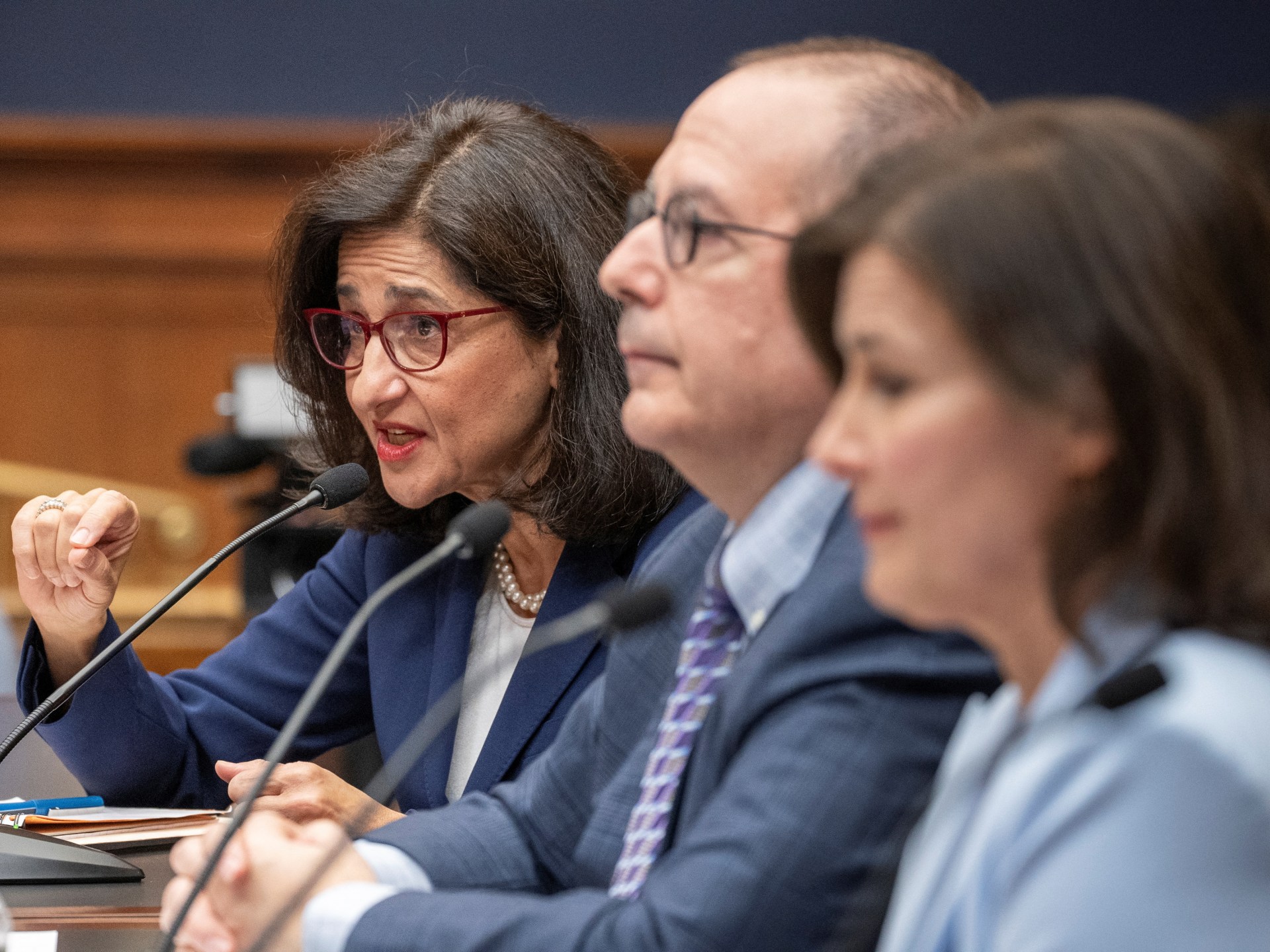
 World1 week ago
World1 week agoColumbia University leaders face scrutiny over anti-Semitism on campus
-
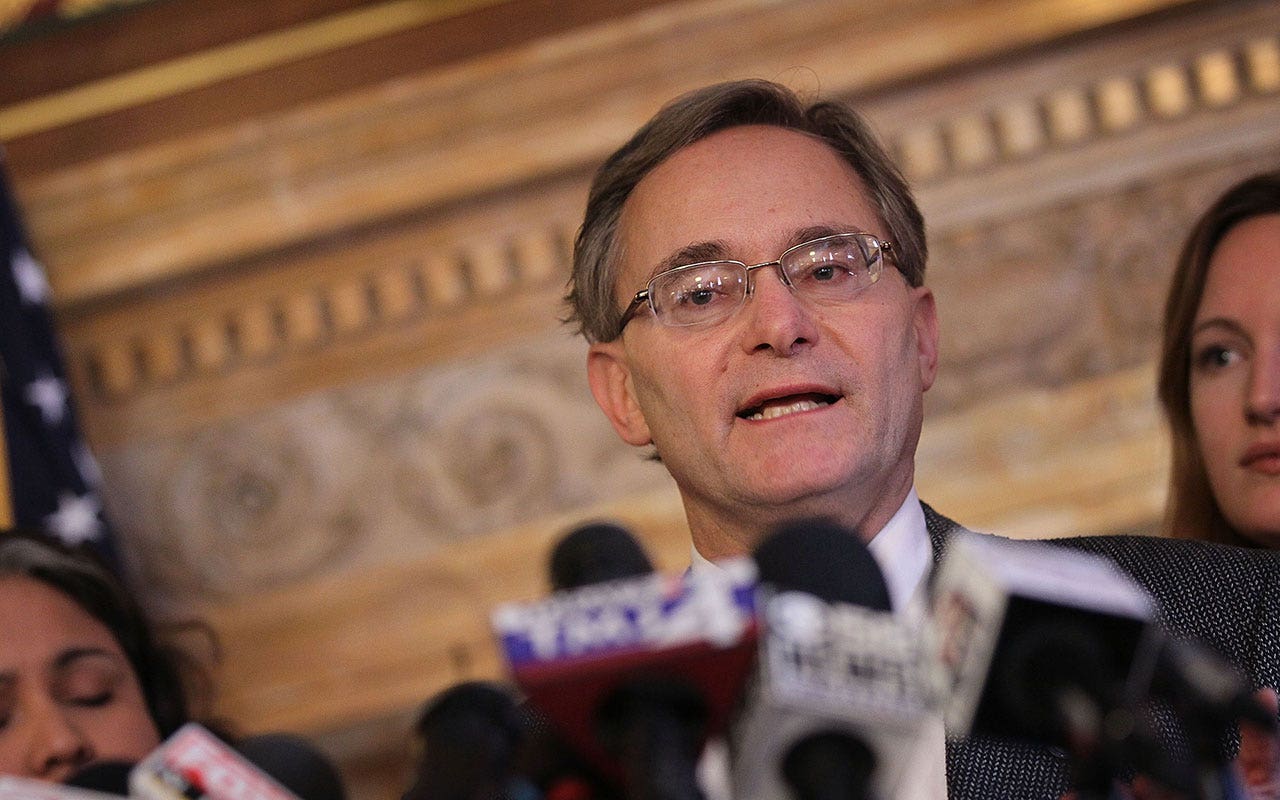
 Politics1 week ago
Politics1 week agoFormer Wisconsin Democratic Rep. Peter Barca launches congressional comeback bid
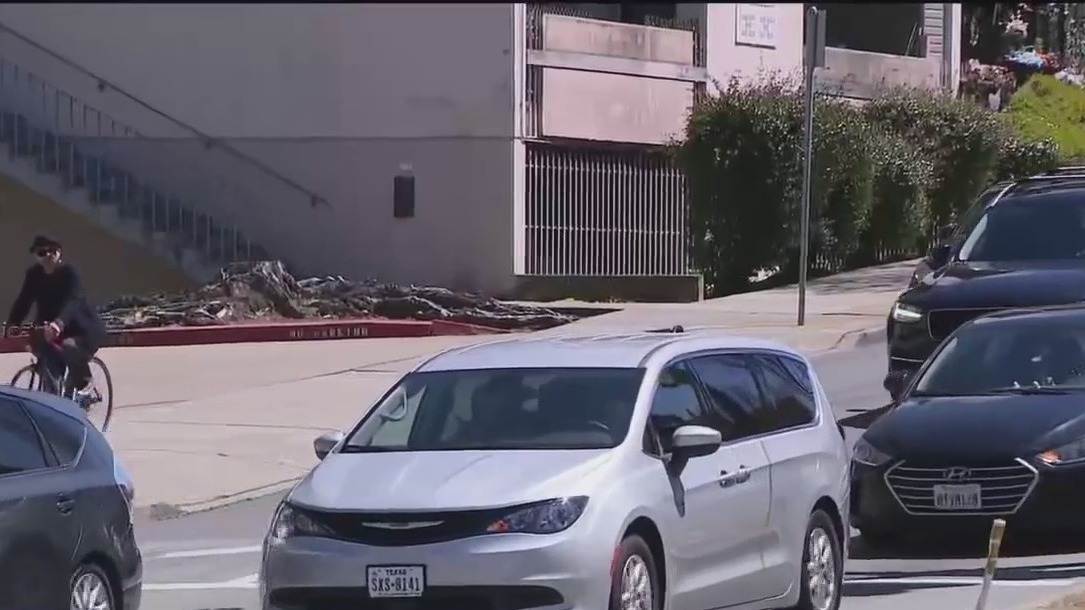
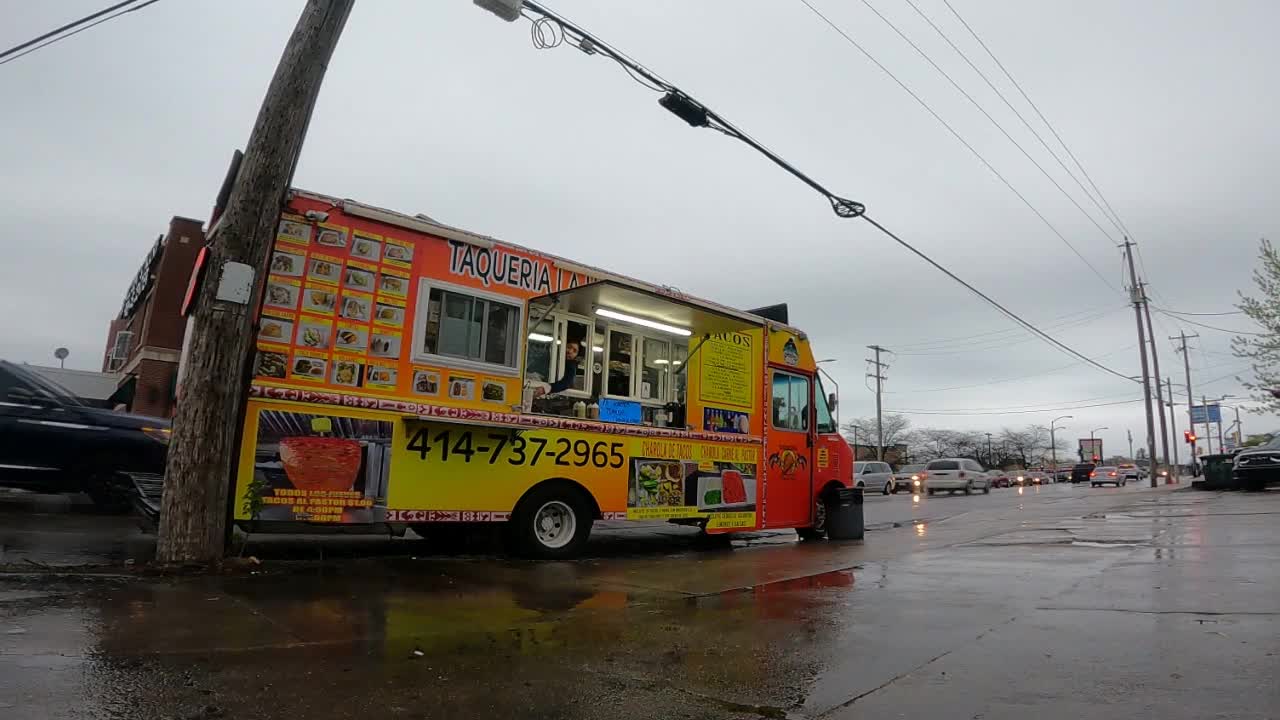
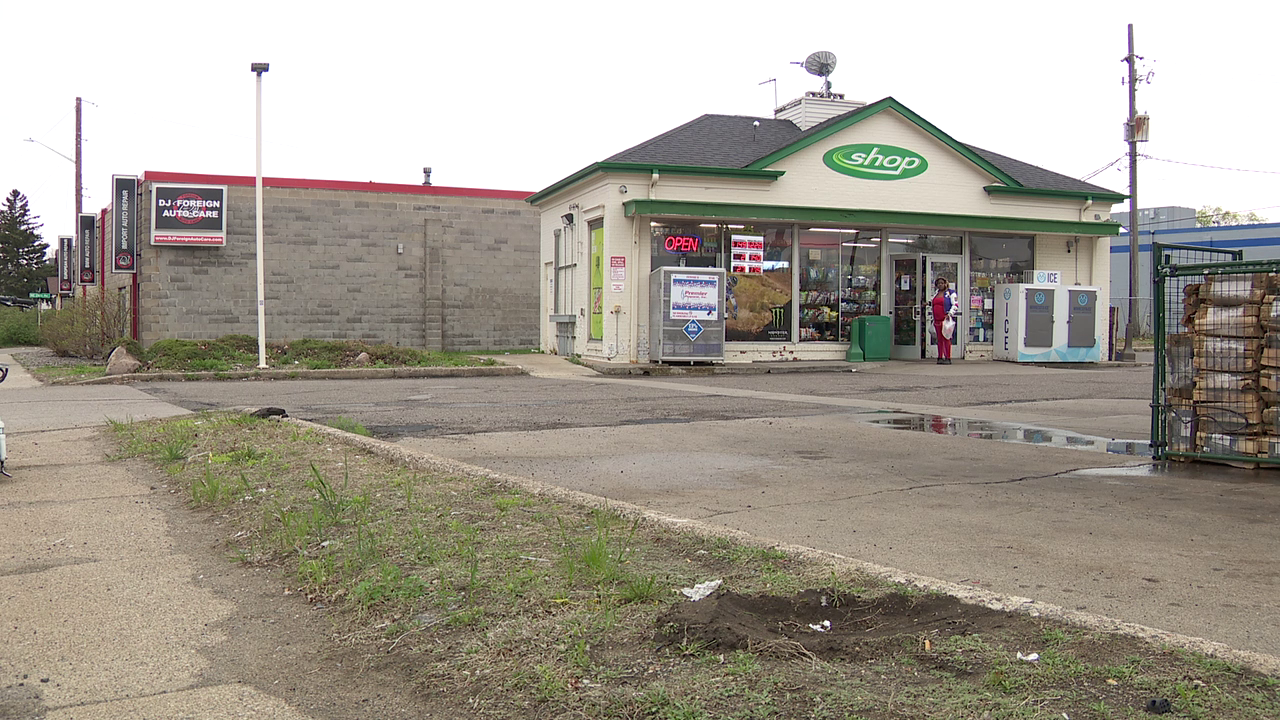

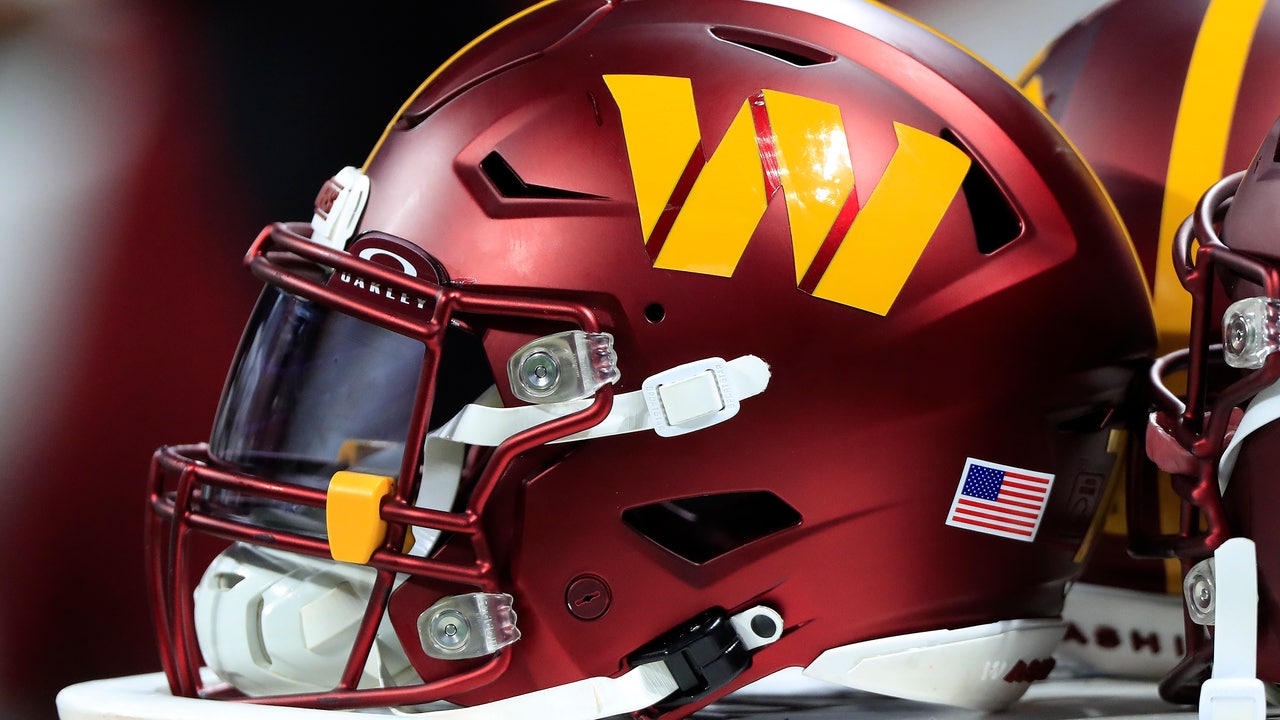
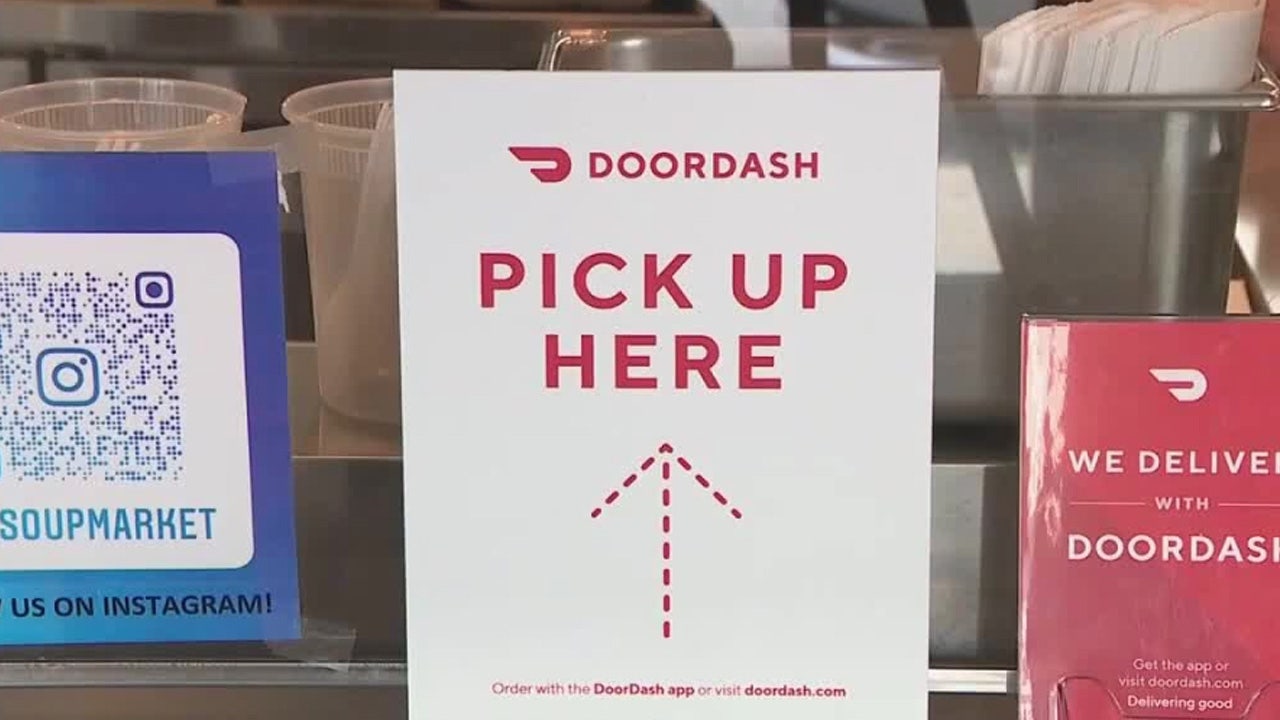



/cdn.vox-cdn.com/uploads/chorus_asset/file/25249712/246961_Costa_Rica_Renewables_2_IVargas.jpg)





